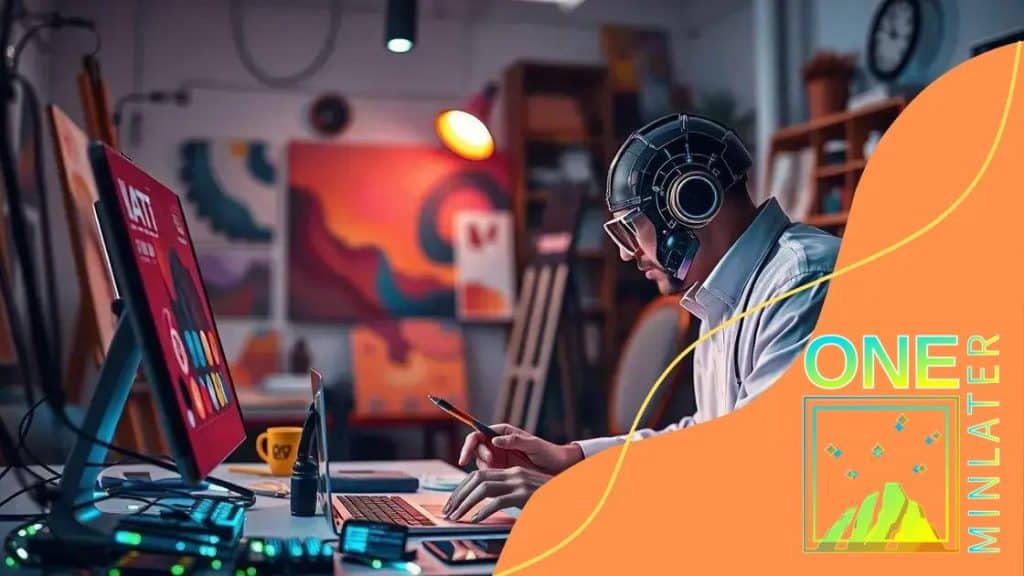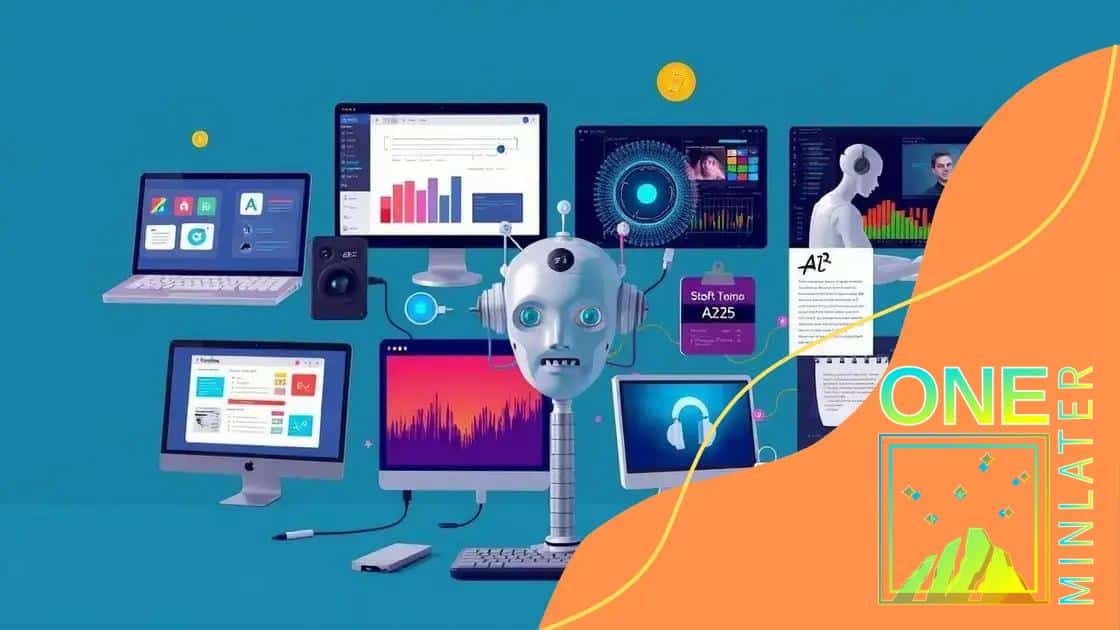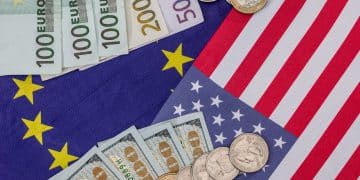The role of AI in transforming the creative industries

The role of AI in transforming the creative industries involves enhancing creativity through collaboration, automating tasks, and providing personalized content while addressing ethical concerns and adapting to future trends.
The role of AI in transforming the creative industries is becoming increasingly evident. From visual arts to design, AI tools are reshaping how creators work and interact. Have you ever wondered how these advancements could redefine your own creative endeavors?
How AI enhances creative processes
AI is increasingly becoming a key player in how we create and innovate. By analyzing data and patterns, AI helps artists, designers, and creators enhance their work and streamline their processes.
Boosting Creativity with AI Tools
One of the most exciting aspects of AI in creative fields is how it can boost creativity. Tools like AI-driven design software can generate unique ideas that a human might not easily conceive. This allows artists to explore new concepts and push their boundaries.
- AI can suggest color palettes and layouts.
- It assists in generating variations of a design.
- AI tools analyze trends and offer insights.
- Some systems even produce music and art automatically.
This capability means that artists are not just limited to their own imaginations. Instead, they have a vast array of resources and suggestions at their fingertips. For example, in graphic design, AI can analyze popular styles and suggest elements that could enhance a project.
Real-Time Feedback and Iteration
Another way AI enhances creative processes is through real-time feedback. This allows creators to make immediate adjustments based on analytical insights. Through machine learning, AI can evaluate how an audience reacts to certain designs or art pieces.
With tools that provide instant feedback, creators can iterate rapidly, improving their work continuously. The result? A more engaging and refined final product. AI’s integration into the creative process fosters a dynamic environment where artists can innovate without fear of making mistakes.
- Using AI analytics leads to better audience engagement.
- It helps streamline workflows by automating repetitive tasks.
- Real-time adjustments can enhance overall quality.
Ultimately, AI helps artists and creators focus on the more human aspects of their work by taking care of the technical details.
Expanding Artistic Boundaries
As more creators adopt AI technology, the traditional boundaries of art are expanding. No longer are creators confined to conventional methods; AI offers a chance to explore new mediums and expressions.
This convergence of technology and creativity invites unique collaborations between human artists and AI systems. From virtual reality installations to AI-generated music performances, AI is profoundly changing what is considered art.
AI is not just a tool; it’s a collaborator that pushes the limits of what we can create together. As we delve deeper into this era, the possibilities seem endless as AI continues to evolve alongside creative minds.
The impact of AI on traditional artistic roles
The impact of AI on traditional artistic roles is significant and evolving. As AI technologies become increasingly sophisticated, they are redefining the landscape of creative professions.
Redefining Artistic Roles
Artists and creators are finding that AI is not just a tool, but a partner in their work. This collaboration is altering how creative tasks are perceived and executed, allowing for new forms of expression.
- AI can automate repetitive tasks.
- It helps in generating initial design concepts.
- Collaboration with AI can inspire new styles.
- Artists can focus on refinement rather than initial creation.
For instance, graphic designers can rely on AI to create multiple variations of a concept, allowing them to choose the best one for further development. This shift empowers artists to explore their creativity in ways that weren’t possible before.
Challenges and Opportunities
While AI opens up many opportunities, it also presents challenges to traditional artistic roles. Some artists worry that reliance on AI may dilute their unique creative voice. However, this concern also invites artists to redefine their roles.
Embracing AI requires a new skill set. Artists must learn to work alongside these technologies, adapting to new workflows. As a result, creators are becoming more versatile and innovative. Many have started to see AI as a catalyst for their creativity, rather than a threat.
- Learning to integrate AI can enhance creative outcomes.
- It encourages artists to experiment with new techniques.
- The blend of AI and human creativity can lead to groundbreaking work.
Moreover, the art industry itself is evolving. Curators and gallery owners are beginning to look for works that combine traditional techniques with AI-generated elements. This fusion is creating a new dialogue within the art community about what constitutes creativity.
The Future Landscape of Artistic Work
As AI continues to develop, it will further integrate into the fabric of creative industries. This evolution suggests a future where human artists and AI systems collaborate more closely, resulting in innovative artistic expressions.
The continued integration of AI means that traditional roles will not disappear, but rather transform. Artists will have the chance to redefine what it means to be creative in an age of technology. In this new landscape, embracing change will be key to thriving.
Examples of AI tools in the creative sector

Examples of AI tools in the creative sector showcase the exciting ways technology enhances creativity. These tools range from design software to music generation platforms, each offering unique features that help artists express their ideas.
Design and Illustration Tools
AI-powered design tools are designed to assist graphic designers and illustrators. Tools like Canva and Adobe Sensei use AI to provide suggestions and make design processes easier.
- Canva’s Magic Resize helps fit designs for different platforms.
- Adobe Sensei automates tasks like photo editing and layout optimization.
- These tools allow designers to focus on creativity rather than mechanical tasks.
By automating tedious parts of the design process, artists can dedicate more time to brainstorming and refining their concepts. AI tools not only enhance efficiency but also encourage experimentation in artistic styles.
Music Generation Software
In the music industry, AI is changing how compositions are created. Platforms such as Amper Music and AIVA use artificial intelligence to compose music tailored to specific moods or themes.
- Amper Music allows users to create custom tracks in minutes.
- AIVA can compose pieces based on user-defined parameters.
- These AI tools democratize music creation, making it accessible to everyone.
This means that even those without formal music training can create professional-sounding compositions. AI simplifies the music production process and opens the door for new musical genres and styles.
Video and Animation Tools
AI is also making waves in video editing and animation. Tools like Magisto and Synthesia leverage AI to streamline video creation.
With Magisto, users can turn raw footage into polished videos automatically, while Synthesia allows the creation of AI-generated avatars for presentations and tutorials. These innovative solutions drastically reduce the time needed for video production.
As a result, creators can produce content faster and more efficiently. The future of video content creation is bright, thanks to these AI advancements.
Text and Content Creation
AI tools extend to the realm of writing as well. Software like Jasper and Grammarly utilize AI to assist content writers.
- Jasper helps generate ideas and improve writing flow.
- Grammarly offers real-time feedback on grammar and tone.
- These tools enhance the writing process, making it easier to create engaging content.
By using AI, writers can enhance their work while maintaining their unique voice. The integration of these tools promotes creativity and enables artists to focus on their message.
Challenges faced in integrating AI into creativity
Challenges faced in integrating AI into creativity can be complex and varied. As artists and creators adopt AI technologies, they encounter both practical and philosophical issues.
Technical Limitations
One of the main challenges is the technical limitations of AI tools. While these technologies are advancing, they are not always perfect. For instance, AI might struggle to understand the nuances of human emotions or cultural contexts.
- AI often lacks the emotional depth found in human-created art.
- Technical glitches can disrupt the creative process.
- Sometimes, AI-generated outputs do not meet artistic standards.
These limitations can frustrate artists who rely on technology for their work. As a result, artists often have to work around these obstacles, mixing human creativity with machine assistance.
Loss of Creative Control
Another significant concern is the potential loss of creative control. Artists may fear that by using AI, they will become overly dependent on technology. This dependence can lead to a dilution of their individual styles and artistic voices.
When artists lean too much on AI tools, they might find themselves following AI suggestions rather than pursuing their unique vision. This fear of conformity can hinder artistic innovation, making it essential for artists to maintain a balance between AI and their creativity.
Ethical Considerations
Ethical concerns also arise when integrating AI into the creative process. Questions about authorship and ownership of AI-generated works can create tension within the artistic community.
- Who owns the rights to an artwork created with AI?
- Is it fair to credit an AI as a collaborator?
- How do we protect traditional artists from being overshadowed by AI-generated content?
These ethical dilemmas can create uncertainty for artists navigating the new landscape of creativity with AI. Discussions about rights and responsibilities are crucial for shaping the future of art in this technology-driven world.
Public Perception
Finally, public perception plays a significant role in the challenges artists face. Some audiences may not fully accept AI-generated art, seeing it as less genuine than human-created works. This skepticism can impact how artists choose to use AI in their projects.
Artists may feel pressured to justify using AI tools to connect with their audience. Overcoming these perceptions will take time and require artists to educate the public about the creative processes involved with AI.
Future trends in AI and creativity
Future trends in AI and creativity are shaping the way artists and creators will work in the coming years. As AI technology evolves, it will significantly influence creative processes across various fields.
Increased Collaboration Between AI and Humans
One major trend is the growing collaboration between AI systems and human artists. This partnership allows each to complement the other’s strengths. As AI becomes more adept at understanding artistic intent, artists can work with AI to enhance their creative output.
- AI can generate new ideas based on artists’ styles.
- Collaborative projects will become more common.
- Artists will have more tools for innovation.
As artists become more comfortable working with AI, we will see a rise in unique art forms that blend both human and machine creativity, pushing the boundaries of traditional art.
Personalized Creative Experiences
Another exciting trend is the ability of AI to create personalized content. With advancements in machine learning, AI can analyze individual preferences and generate customized artistic experiences.
For example, AI can curate music playlists or create specific art pieces that resonate with a person’s taste. This personalization means that audiences can engage with art on a deeper level, making it more meaningful.
AI in Education and Skill Development
AI will also play a vital role in education and creative skill development. New platforms that use AI can help aspiring artists learn and refine their craft.
- AI tutors can provide feedback on students’ work.
- Creative tools will become more accessible for beginners.
- Educational resources will adapt to individual learning speeds.
With these advancements, more people will have the opportunity to express themselves creatively, breaking down barriers to entry in various artistic fields.
Expansion of AI Generated Content
The emergence of AI-generated content will continue to grow, with more industries embracing it. From advertising to entertainment, AI will produce content that aligns with trends and consumer demands.
As creatives adopt AI in their workflows, we will likely see more hybrid creations that combine human elements with AI enhancements. This fusion can lead to exciting directions in storytelling and visual arts.
Overall, future trends in AI and creativity are set to redefine the artistic landscape, offering new opportunities for both artists and audiences alike.
In conclusion, the integration of AI into the creative industries presents both exciting opportunities and unique challenges. As artists navigate this evolving landscape, they will find new ways to collaborate with technology, leading to innovative art forms and personalized experiences. It’s essential to remain aware of the ethical implications and technical hurdles that may arise. However, with the right balance, artists can harness the power of AI to enhance their creativity and reach new audiences. The future of art is bright, and AI will play a significant role in shaping it.
FAQ – Frequently Asked Questions about AI in Creative Industries
How does AI enhance the creative process for artists?
AI enhances the creative process by providing tools that automate repetitive tasks, generate new ideas, and offer personalized content, allowing artists to focus more on their creativity.
What are some popular AI tools used in art and design?
Popular AI tools include Canva for design, AIVA for music composition, and Magisto for video editing, all of which assist creators in various aspects of their work.
What ethical concerns arise from using AI in creativity?
Ethical concerns include questions about authorship, copyright issues, and the potential for AI to overshadow human creativity, leading to discussions about rights in the art community.
How can artists prepare for the future of AI in their work?
Artists can prepare by staying informed about technological advancements, experimenting with AI tools, and integrating them into their practices while maintaining their unique creative voice.





